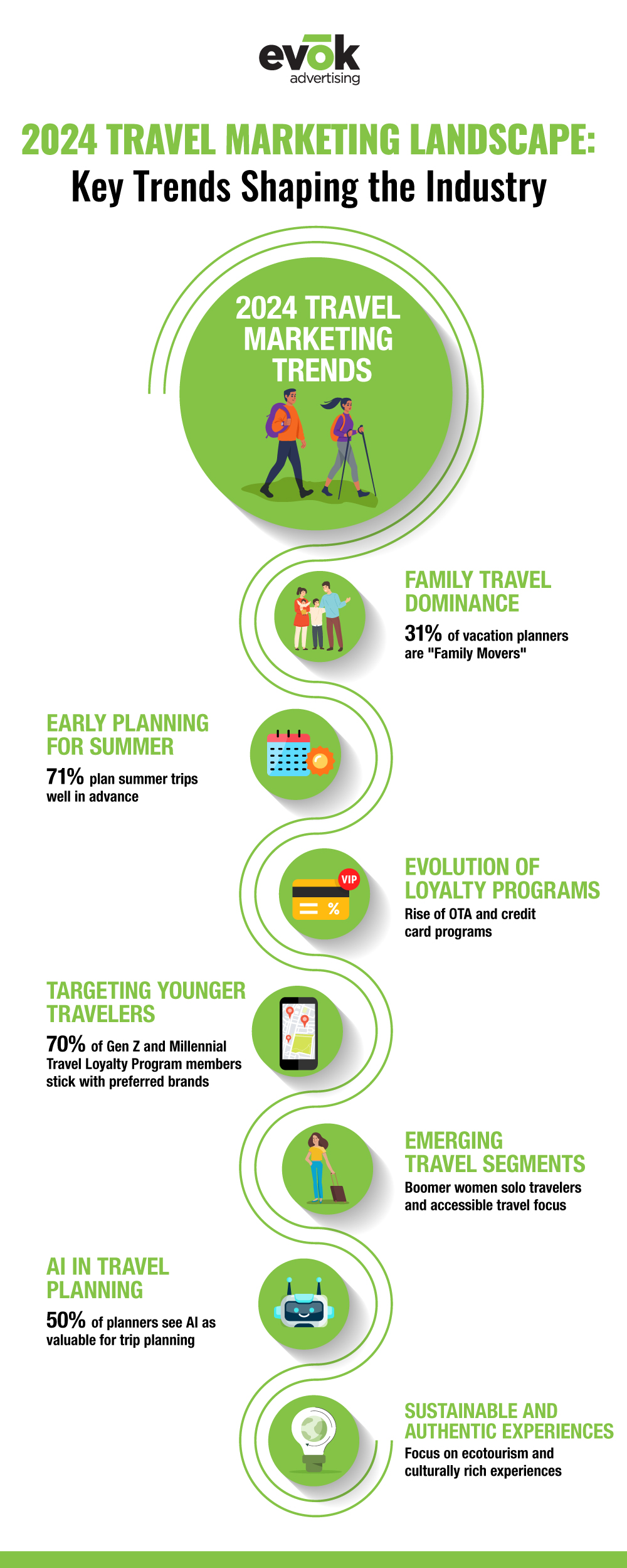
Top Travel Marketing Trends in 2024: Vacation Planning, Family Travelers & More
The post-pandemic era has ushered in a new traveler’s mindset, with demand for travel experiences remaining remarkably strong. As a leading destination marketing agency, we’ve observed that despite rising costs due to inflation, consumers show no signs of fading wanderlust. The travel and tourism sector is poised for steady growth in the coming years.
This resilience in travel demand is reshaping marketing strategies across the industry. From luxury travel to family vacations, and bustling urban destinations to eco-friendly getaways, travel companies are adapting their approaches to meet today’s travelers’ changing preferences and expectations.
In this blog post, we’ll explore the top travel marketing trends of 2024, diving into how vacation planning has shifted, why family travelers are becoming a driving force in the industry and what new factors are influencing travelers’ decisions. We’ll also look at how digital marketing, social media and emerging technologies play crucial roles in shaping the future of travel marketing.

Family Travel Takes Center Stage
In 2024, we’re witnessing a seismic shift in the travel landscape, with family travelers emerging as a dominant force shaping industry trends. The “Family Movers” segment, largely comprised of Millennial parents, now represents a whopping 31% of vacation planners – the largest subset in the market. This demographic isn’t just numerous; they’re setting the tone for what travel brands and destinations need to provide.
This surge in family travel is more than a fleeting trend; it’s transforming the travel ecosystem. Millennial parents, with their unique blend of adventure-seeking and family-first mentalities, are redefining what family vacations look like. They’re not content with the outdated cookie-cutter family resorts. Instead, they’re demanding enriching experiences for their kids and fulfilling for themselves.
Travel companies are taking note and rapidly evolving their offerings to cater to this influential group. We’re seeing a rise in family-friendly experiences beyond the typical kids’ club. Think interactive cultural experiences, eco-adventures educate about sustainability and multi-generational activities create lasting memories.
But it’s not just about the activities. The entire travel journey is being reimagined with families in mind. Every touchpoint is optimized for family travelers, from seamless booking processes accommodating multiple travelers to accommodations offering the perfect blend of togetherness and privacy.
Moreover, this trend is influencing marketing strategies across the board. Content marketing efforts are increasingly focused on showcasing authentic family moments, while social media campaigns are tapping into the power of family influencers to reach this lucrative market.
Early Planning and Summer Travel: The New Norm

As we delve deeper into 2024’s travel landscape, a striking pattern has emerged: the rise of the early bird traveler. A whopping 71% of vacationers are setting their sights on summer escapades, but here’s the kicker – they’re not leaving their plans to the last minute. This same percentage of travelers prefer to meticulously plan their trips as far ahead as possible, signaling a profound shift in booking behaviors.
The implications are clear: brands must be on their A-game, reaching potential travelers early and often. Gone are the days of last-minute deal scrambles. Instead, we’re seeing a strategic pivot towards year-round engagement, with marketing efforts ramping up well before summer begins.
Smart travel marketers are capitalizing on this trend, crafting compelling narratives and irresistible offers months in advance. They’re tapping into the anticipation and excitement that comes with long-term planning, using everything from teaser campaigns to early bird discounts to capture the imaginations – and bookings – of these forward-thinking travelers.
The Rise of Loyalty Programs: A New Era of Travel Perks

In an age of skyrocketing travel costs and economic uncertainty, Travel Loyalty Programs (TLPs) are emerging as the unsung heroes of the savvy traveler’s toolkit. These programs are no longer just nice-to-have perks; they’re becoming essential tools for making travel more accessible and rewarding in the face of rising prices.
But here’s where it gets interesting: we’re witnessing a dramatic shift in the loyalty landscape. Traditional airline and hotel programs face stiff competition from a new breed of loyalty schemes. Credit card and Online Travel Agency (OTA) programs are gaining serious traction, especially among the younger crowd. Gen Z, in particular, is leading this charge, with a staggering 30% of them pledging allegiance to OTA programs – more than any other generation.
This shift is forcing travel brands to rethink their loyalty strategies from the ground up. Members are clamoring for more flexibility and relevance in their rewards. A significant 41% of TLP members are eager to rack up points through everyday retail spending, while 39% push for alliances between travel and non-travel programs. The message is clear: travelers want their everyday actions to count towards their next getaway.
But it’s not just about accumulating points. The younger generation of travelers—Gen Z and Millennials—is redefining brand loyalty in the travel industry. This presents a golden opportunity for travel companies, but it comes with a caveat: these savvy young travelers expect top-notch redemption options and experiences in return for their allegiance.
Targeting Younger Travelers: The New Power Players

In 2024, the travel industry is witnessing a substantial shift as Gen Z and Millennials emerge as the powerhouses of travel consumption. These digital natives aren’t just dipping their toes in the travel waters; they’re diving in headfirst, reshaping the landscape of travel marketing.
Here’s a startling statistic sending ripples through the industry: over 70% of Gen Z and Millennial Travel Loyalty Program (TLP) members are willing to stick with their preferred brand, even when more budget-friendly options are on the table. This brand loyalty isn’t just impressive; it’s a game-changer. But make no mistake – it comes with sky-high expectations.
These young travelers are redefining what it means to be a valuable customer. They’re tech-savvy, experience-hungry and demand more than just a comfortable bed or a timely flight. They’re looking for brands that align with their values, offer unique experiences and, most importantly, keep up with their ever-evolving preferences.
For travel brands, this presents both a challenge and an unparalleled opportunity. The key to capturing and retaining these young travelers is constant innovation, particularly in redemption options. Static, one-size-fits-all reward programs simply won’t cut it anymore. These travelers crave personalized experiences, exclusive access and rewards to reflect their individuality.
Smart travel companies are rising to the challenge. They’re leveraging data analytics to understand the nuanced preferences of their younger members. They’re crafting bespoke experiences beyond traditional travel rewards – think exclusive concerts, sustainable travel options or behind-the-scenes cultural experiences. The message is clear: to win Gen Z and Millennial travelers’ hearts (and wallets), brands need to be as dynamic and multifaceted as their target audience.
Emerging Travel Segments: Solo Female Travelers and Accessibility Pioneers
As we venture further into 2024, two distinct travel segments are carving out significant niches in the industry: solo female travelers and those seeking accessible travel experiences.
First, let’s talk about the rise of solo female travelers, particularly among married Boomer women. This isn’t just a trend; it’s a movement. These women are redefining what it means to travel in your golden years. They’re not content with predictable package tours or sedentary cruises. Instead, they’re seeking challenging adventures, enriching experiences and journeys that allow them to redefine themselves outside their traditional roles.
Travel brands are taking notice, crafting tailored experiences to speak to the desires of this powerful demographic. We’re seeing the emergence of women-only tours which combine adventure with safety, wellness retreats focusing on self-care and cultural immersion experiences catering to the curiosity and vibrancy of these solo female travelers.
Simultaneously, the travel industry is undergoing a revolutionary shift towards accessibility. This isn’t just about retrofitting existing destinations for people with physical disabilities – although that’s certainly part of it. The real game-changer is the increasing integration of accessibility into the very design process of travel experiences.
Forward-thinking brands are reimagining every aspect of the travel journey through the lens of accessibility. From transportation networks to accommodation designs, attraction layouts to digital interfaces, accessibility is becoming a core consideration rather than an afterthought.
This focus on accessible travel isn’t just opening the world to travelers with varying needs—it’s enhancing the travel experience for everyone. User-friendly designs, clear communication and thoughtful services benefit all travelers, creating a more inclusive and enjoyable experience across the board.
The Role of AI in Travel Planning: A Digital Revolution

As we navigate the complex travel landscape in 2024, AI emerges as both a disruptor and an enabler. The travel industry finds itself at a fascinating crossroads, with 50% of vacation planners believing AI can be a valuable asset in their journey, while the other half remains skeptical.
This split opinion presents a unique challenge for travel brands: They must deliver useful AI-powered services and prove their superiority over traditional methods. It’s no longer enough to offer an AI chatbot simply; the technology needs to provide tangible, superior value to the traveler’s experience.
Cutting-edge travel companies are rising to this challenge with innovative AI applications. We’re seeing the emergence of hyper-personalized travel recommendations go beyond simple preferences, tapping into travelers’ past behaviors, current trends and even predictive analysis of future desires. AI-powered virtual travel assistants are becoming more sophisticated, offering real-time support, from flight delay predictions to local cuisine recommendations based on individual tastes.
But the real game-changer lies in AI’s ability to enhance the human touch, not replace it. Smart travel brands use AI to handle routine tasks, freeing human agents to provide more nuanced, empathetic service where it matters most. This blend of high-tech and high-touch is setting new standards in customer service.
Sustainable and Authentic Travel Experiences: The New Travel Currency
In 2024, the buzzwords ‘sustainable’ and ‘authentic’ aren’t just trendy marketing terms – they’re the new currency in the travel industry. Today’s travelers, particularly the influential younger demographics, are no longer satisfied with surface-level experiences or environmentally questionable practices. They seek deep, meaningful connections with their destinations and demand responsible travel options.
The focus on ecotourism and sustainable travel has evolved from a niche interest to a mainstream expectation. Travelers actively seek brands and destinations that prioritize environmental conservation, support local communities and minimize carbon footprint. This shift drives innovation across the industry, from zero-waste hotels to carbon-neutral transportation options.
But sustainability is just one piece of the puzzle. There’s a growing appetite for authentic, culturally rich experiences beyond typical tourist traps. We’re seeing a fascinating trend toward exploring historically marginalized communities and significant locations that offer a deeper, more nuanced understanding of a destination’s culture and history.
Travel brands respond to this demand by forging partnerships with local communities, offering immersive cultural experiences benefiting travelers and locals alike. From indigenous-led tours to homestays in traditional villages, these experiences offer travelers a chance to connect with a place on a profound level.
This trend towards authenticity extends to culinary experiences as well. Food tourism is booming, with travelers seeking local, traditional cuisines and farm-to-table experiences telling a place’s story through its flavors.
The key lies in storytelling – weaving narratives highlighting a destination’s unique, authentic aspects while emphasizing its commitment to sustainability. Content marketing strategies are evolving to showcase behind-the-scenes sustainability efforts, spotlight local cultural preservationists and offer insider glimpses into local experiences.
Personalized Travel and Tourism Marketing
As we approach 2024, the travel industry is experiencing a renaissance driven by evolving consumer preferences and technological advancements. The landscape we’ve explored – from the dominance of family travelers to the rise of sustainable tourism – reveals an industry recovering and reinventing itself.
The critical insight for travel marketers is this: success in this new era hinges on creating seamless, personalized and meaningful travel experiences to resonate across generations. It’s no longer about selling a destination but curating journeys aligning with travelers’ values, lifestyles and aspirations.
Ready to stay ahead of these evolving travel trends? Partner with a leading destination marketing agency that understands the complex dynamics of today’s travel landscape. Our destination marketing experts can help you create personalized strategies that resonate with your target audience and drive meaningful results. Contact us today to transform your destination’s marketing approach and capture the opportunities of tomorrow.